My PLC for the track slippage warning system (TSWS) came yesterday and I got to play with it and get it working on my desk. Here's my bench-test setup. The PLC is the black square box at bottom left. To recap, the PLC will receive pulses from a sensor monitoring each drive axle rpm and compare them. A substantial difference in the counters will light up the appropriate LED on the dash to show which track is slipping from lack of traction. I can then brake that side to add torque to the opposite track. I hope to get the system installed before the next big storm. Does anyone need a system like this? Happy New Year everyone! :thumbsup:
View attachment 681702
I've devoted a lot of thought to high speed skid-steer vehicle control over the past few years, heck I guess it's been a decade, or ever since Ripsaw came along. I have lots of ideas but no time to try them. It seems you have a lot more time than I do, so I'll throw a couple of ideas out and maybe you'll find one of them promising.
Hydraulics are horribly inefficient compared to the mechanical drive that you have. The efficiency of the mechanical drive is diminished by side-braking to steer. IMO it would be best to
redirect power from one side to the other rather than dissipate it into a brake on one side. Yes, I realize that when you brake one side, the diff "redirects" the power to the other side, but you're still wasting an appreciable amount of energy (I think - never done the math - have you?)
To redirect the power you could use a number of means. Hydraulic solutions, mechanical solutions, electrical solutions. The Hydraulic solution would involve a pair of variable displacement swashplate pumps, hydraulically cross-connected, and mechanically one pump coupled to each side of the diff. I know I said hydraulics are inefficient, but this wouldn't be so bad because the hydraulics aren't driving the locomotion, just augmenting it. Cruising in a straight line, the swashplates of both pumps are straight, no fluid is being pumped. You want to turn, you pull a stick that's connected to both swashplates, one pump turns into a pump and the other one turns into a motor. The pump feeds the motor. Basically a hydrostatic supplemental system. The power is redirected in a controlled manner and the jerkiness of mechanical side-braking is gone.
The electrical solution is probably the best, and the most expensive. Same concept, a pair of wound field DC motors is coupled to either side of the diff. You move a joystick which turns a rheostat controlling the field current of one motor and it starts producing higher voltage (power (drag)) which feeds the other side; one side turns into a generator and the other side a motor powered by it, resulting once again in a smooth turn. You could do this with more advanced technology, induction motors and VFDs, servo motors and amplifiers, BLDCs, the more advanced you go, the more control you have. You could program it to have steering force proportional to cruising speed, so can turn on a dime in your driveway without turning on a dime on the interstate and flipping.
I think my favorite is the mechanical solution. Simple, cheap. A variator is coupled via intermediate shafts to both sides of the diff. Maybe variator isn't the right word... CVT? I'm sure you're familiar with the "torque converter" setups that snowmobiles use? Two variable diameter pulleys whose diameters vary by opening or closing half-sheaves. The belt naturally conforms to the pulleys as they change. These are normally outfitted with a centrifugal clutch in the driving pulley and spring closer in the driven pulley, but you could roll your own where the two pulleys are opened/closed on demand from a cable or a lever. They could be arranged so that they ride on a fulcrum; when one opens the other closes and vise versa.
The point of these ideas is to maximize efficiency and improve high speed control. I didn't think you would need that until you mentioned it now being capable of 50mph. Can you imagine driving that thing 50mph and squeezing the brake on one side? Honest question, you have more experience with tracked vehicles than I do, especially in the design. To me it seems scary as ****, but maybe it isn't.


![20201231_133353[1].jpg 20201231_133353[1].jpg](https://www.tractorbynet.com/forums/data/attachments/584/584403-bbc408523528c998ce105c0229109f1a.jpg)
